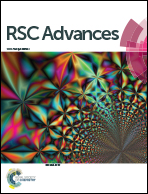Solvent-free fabrication of multi-walled carbon nanotube based flexible pressure sensors for ultra-sensitive touch pad and electronic skin applications†
Abstract
This paper reports the solvent free, low cost fabrication and clean process of an ultrasensitive touch pad by sandwiching multi walled carbon nanotubes (MWCNTs) between a bottom polyimide (PI) substrate and top cellulose paper using rolling pins and pre-compaction mechanical pressing techniques. The sensing mechanism is due to pressing force dependent contact of MWCNTs between the top cellulose paper and bottom PI. The recently developed solvent free pencil on paper approach for fabricating pressure sensors has the drawback of low throughput which hinders its applicability in commercial domain. Here in this work, the entire fabrication process is scalable and could be integrated to a large area for mapping spatial pressure distribution. The as fabricated sensor has sensitivity of 0.549 kPa−1, response time of <32 ms and low power consumption of <1.9 mW. Apart from measuring pressing, tensile and compressive forces, the sensor can identify acoustic vibrations from a loud speaker. The fabricated pressure sensor was further applied as artificial electronic skin with 3 × 4 pixel array wherein it was observed that measured spatial distribution was consistent with shape and location of the object. This proposed flexible touch pad fabricated by a low energy fabrication and clean process technology paves way for future wearable electronics such as flexible touch pads and human–machine interfaces.


 Please wait while we load your content...
Please wait while we load your content...